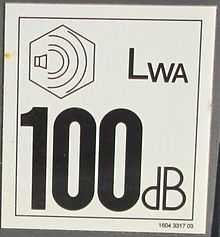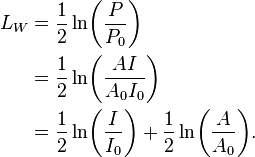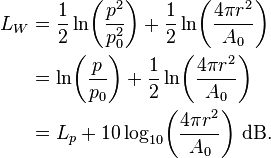Sound power
| Sound measurements | |
|---|---|
Characteristic |
Symbols |
| Sound pressure | p, SPL |
| Particle velocity | v, SVL |
| Particle displacement | ξ |
| Sound intensity | I, SIL |
| Sound power | P, SWL |
| Sound energy | W |
| Sound energy density | w |
| Sound exposure | E, SEL |
| Acoustic impedance | Z |
| Speed of sound | c |
| Audio frequency | AF |
| Transmission loss | TL |
|
| |
Sound power or acoustic power is the sound energy emitted, reflected, transmitted or received, per unit time.[1] The SI unit of sound power is the watt (W).[1] It is the power of the sound force on a surface of the medium of propagation of the sound wave. For a sound source, unlike sound pressure, sound power is neither room-dependent nor distance-dependent. Sound pressure is a measurement at a point in space near the source, while sound power is the total power produced by the source in all directions. Sound power is sometimes called sound flux or acoustic flux.
Sound power is a rough measure of the loudness of a particular sound, but the human perception of sound is affected by many other factors, such as the sound's frequency or the loss of sound intensity due to distance from the sound's source.
Mathematical definition
Sound power, denoted P, is defined by[2]
where
- f is the sound force of unit vector u;
- v is the particle velocity of projection v along u;
- A is the area;
- p is the sound pressure.
In a medium, the sound power is given by
where
- A is the area of the surface;
- ρ is the mass density;
- c is the sound velocity;
- θ is the angle between the direction of propagation of the sound and the normal to the surface.
For example a sound at SPL = 85 dB or p = 0.356 Pa in air (ρ = 1.2 kg·m−3 and c = 343 m·s−1) through a surface of area A = 1 m2 normal to the direction of propagation (θ = 0 °) has a sound energy flux P = 0.3 mW.
This is the parameter one would be interested in when converting noise back into usable energy, along with any losses in the capturing device.
Table of selected sound sources

Situation and
sound sourceSound power
(W)Sound power level
(dB ref 10−12 W)Saturn V rocket 100,000,000 200 Turbojet engine 100,000 170 Turbofan aircraft at take-off 1,000 150 Turboprop aircraft at take-off 100 140 Machine gun
Large pipe organ10 130 Symphony orchestra
Heavy thunder
Sonic boom1 120 Rock concert
Chain saw
Accelerating motorcycle0.1 110 Lawn mower
Car at highway speed
Subway steel wheels0.01 100 Large diesel vehicle 0.001 90 Alarm clock 0.0001 80 Noisy office
Vacuum cleaner10−5 70 Busy restaurant
Hair dryer10−6 60 Quiet office
Average home10−7 50 Refrigerator
low voice
Quiet home10−8 40 Quiet conversation
Broadcast studio10−9 30 Whisper
Wristwatch ticking10−10 20 Human breath 10−11 10 Reference value 10−12 0
Relationships with other quantities
Sound power is related to sound intensity:
where
- A is the area;
- I is the sound intensity.
Sound power is related sound energy density:
where
- c is the speed of sound;
- w is the sound energy density.
Sound power level
Sound power level (SWL) or acoustic power level is a logarithmic measure of the sound power of a sound relative to a reference value.
Sound power level, denoted LW and measured in dB, is defined by[4]
where
- P is the sound power;
- P0 is the reference sound power;
- 1 Np = 1 is the neper;
- 1 B = (1/2) ln(10) is the bel;
- 1 dB = (1/20) ln(10) is the decibel.
The commonly used reference sound power in air is[5]
The proper notations for sound power level using this reference are LW/(1 pW) or LW (re 1 pW), but the notations dB SWL, dB(SWL), dBSWL, or dBSWL are very common, even if they are not accepted by the SI.[6]
The reference sound power P0 is defined as the sound power with the reference sound intensity I0 = 1 pW/m2 passing through a surface of area A0 = 1 m2:
hence the reference value P0 = 1 pW.
Relationship with sound pressure level
In the case of a free field sound source in air at ambient temperature, the sound power level at distance r from the sound source is approximately related to sound pressure level (SPL) by[7]
where
- Lp is the sound pressure level;
- A0 = 1 m2.
Derivation of this equation:
For a progressive spherical wave,
where z0 is the characteristic specific acoustic impedance.
Consequently,
and since by definition I0 = p02/z0, where p0 = 20 μPa is the reference sound pressure,
The sound power estimated practically does not depend on distance, though theoretically it may diminish with distance due to viscous effects in the propagation of sound.
References
- ↑ 1.0 1.1 Ronald J. Baken, Robert F. Orlikoff (2000). Clinical Measurement of Speech and Voice. Cengage Learning. p. 94. ISBN 9781565938694.
- ↑ Landau & Lifshitz, "Fluid Mechanics", Course of Theoretical Physics, Vol. 6
- ↑ "Sound Power". The Engineering Toolbox. Retrieved 28 November 2013.
- ↑ "Letter symbols to be used in electrical technology – Part 3: Logarithmic and related quantities, and their units", IEC 60027-3 Ed. 3.0, International Electrotechnical Commission, 19 July 2002.
- ↑ Ross Roeser, Michael Valente, Audiology: Diagnosis (Thieme 2007), p. 240.
- ↑ Thompson, A. and Taylor, B. N. sec 8.7, "Logarithmic quantities and units: level, neper, bel", Guide for the Use of the International System of Units (SI) 2008 Edition, NIST Special Publication 811, 2nd printing (November 2008), SP811 PDF
- ↑ Chadderton, David V. Building services engineering, pp. 301, 306, 309, 322. Taylor & Francis, 2004. ISBN 0-415-31535-2












